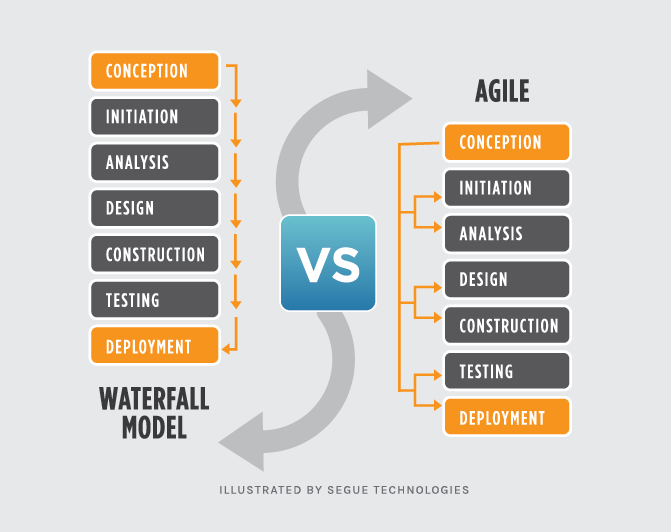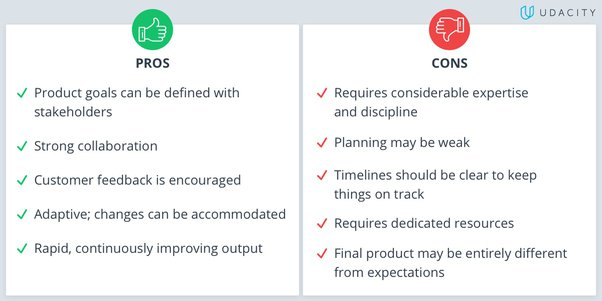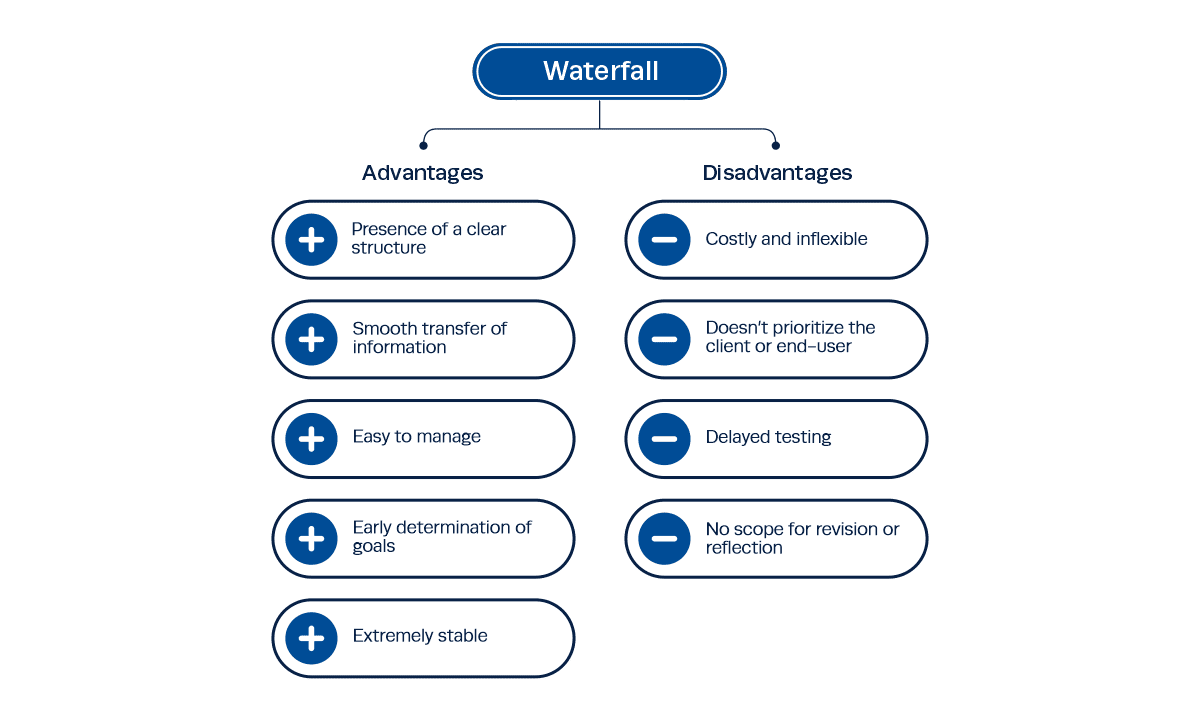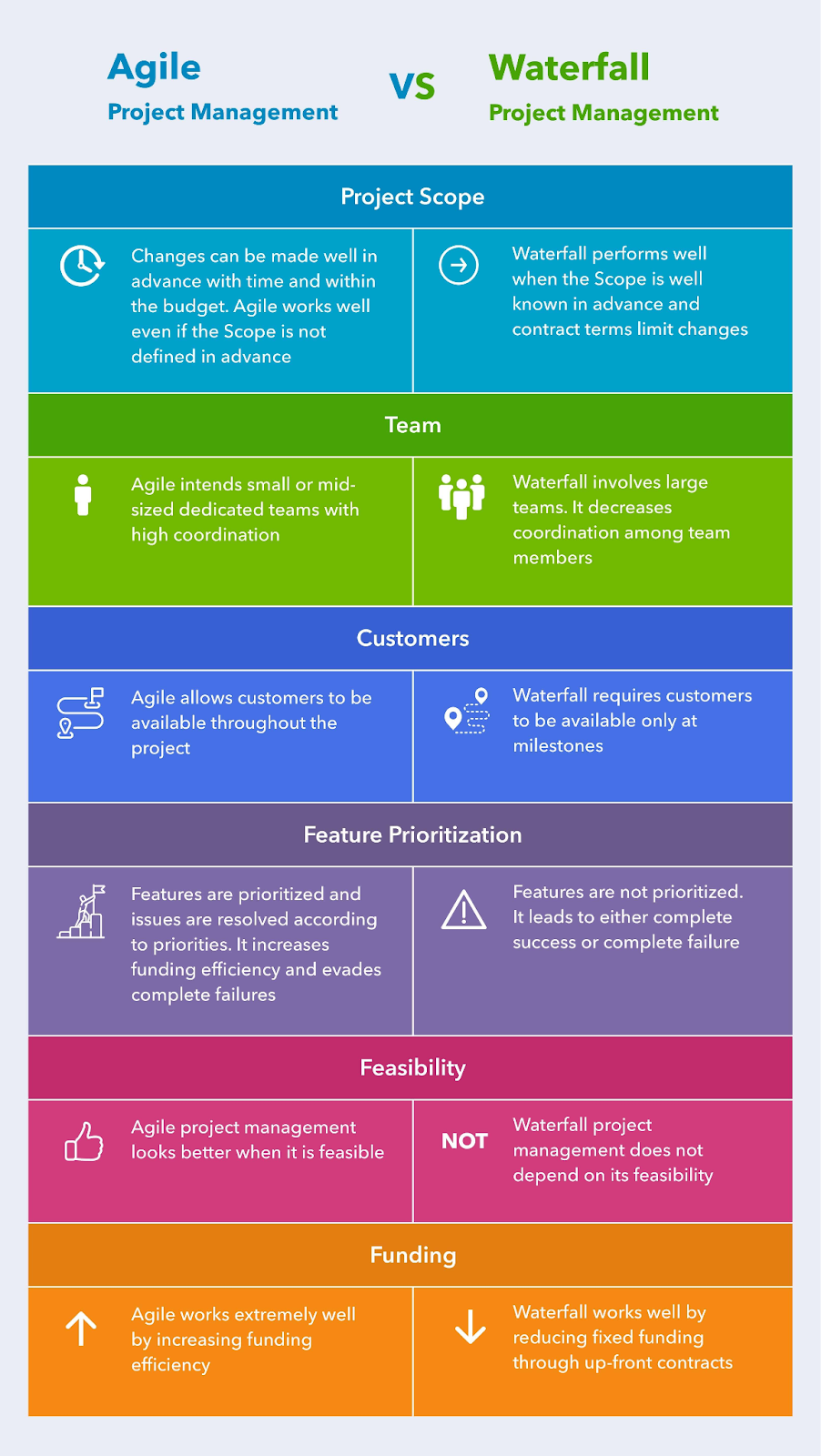The Agile and Waterfall project management methodologies have key differences that impact the course of software development.
While Agile comprises an iterative approach, allowing for scope change and continuous releases, Waterfall adheres to a linear system with a predictable timeline.
Agile methodology emphasizes customer feedback and process changes, ensuring Agile requirements are met through various stages of planning, execution, monitoring, and closing. Conversely, the Waterfall method follows a strict sequence, with limited room for change control once a step is completed.
Introduction to Agile and Waterfall methodologies

Agile and Waterfall are big names in project management, especially for making software. Waterfall is a step-by-step system with a clear timeline. You finish one stage, like planning or doing the work, before starting the next.
But Agile is different. It’s all about making small changes often. Agile is flexible, changing as needed based on what people using the software say. This helps keep everything under control.
Understanding Agile methodology
Agile is a bunch of ways to manage software projects that love to change things up often. It’s all about making small updates and listening to what users say. This keeps the project moving even as things change, which isn’t how older methods usually work.
Agile’s big on planning, doing, checking, and wrapping up, even as things keep changing. It’s about staying nimble but still keeping things on track.
Understanding Waterfall methodology
Waterfall is a classic way to run software projects. It’s a straight line: you plan, then do, then check, then finish. It’s neat and predictable, which some people really like.
Unlike Agile’s quick updates and changes, Waterfall sticks to the plan. Once you start, big changes are tough. You don’t really check in with users until the end, so you need a strong plan from the start.
Are you ready to take your business to the next level? Bonsai is here to make that journey smooth and efficient. With our all-in-one platform, you can streamline every aspect of your business, from client management to financials, all in one place.
Key differences between Agile and Waterfall
Agile and Waterfall stand apart in the world of software project management. Waterfall is a straight-line approach where you plan, then do, then check, then finish, all in order. It’s known for its set schedule.
Agile, on the other hand, is more like a cycle of updates based on what users say. It’s flexible, changing as needed to fit what people need as they use the software.
Planning and design
When starting a software project, picking the right way to manage it is key. You might go with an iterative approach, which means you keep tweaking the project with new updates and user feedback.
Another thing to think about is how you handle changes. With Agile, you can shift gears as needed, which helps keep things moving smoothly, even if plans change.
Flexibility and adaptability
Being able to change and adjust is super important in making software. Whether you’re releasing updates often or following a set plan, you need to keep an eye on how things are going.
Quickly adapting to new needs or changes is crucial. Agile puts a big focus on being able to move with the times, thanks to feedback from users and a solid plan for dealing with changes.
Testing and quality assurance
Testing and making sure everything is up to snuff is a big part of managing software projects. This includes everything from planning to doing to checking to wrapping up.
Quality checks also mean putting out updates often and listening to what users have to say. This helps the team make changes as needed and keep the project on track for a top-notch final product.
Client involvement and feedback
In any software project, what the users think and say is super important. It helps make sure the project sticks to Agile ways and keeps updating.
Letting users know about changes as they happen keeps everything clear. Key parts like dealing with changes and putting out updates are done smoothly, making sure nothing gets in the way of finishing the project.
Pros and cons of Agile methodology

Agile methodology, a prevailing option among project management methodologies, particularly in software development, encompasses some noticeable benefits. These include a flexible iterative approach that ends up in continuous releases, making Agile exceptionally receptive to scope changes based on customer feedback. This customer-centric method supports process changes during the project's planning, execution, and monitoring until closing.
Yet, its benefits can turn into setbacks. The lack of a predictable timeline due to continuous changes can be a negative for those preferring a linear system. The dependency on client participation might also be an obstruction if not well managed.
Benefits of Agile methodology
Agile methodology offers a breath of fresh air into project management methodologies, particularly for software development. This iterative approach to project planning and execution allows for continuous releases, a marked departure from the traditional linear system of development. This enables quicker incorporation of customer feedback, ensuring a product that's more in sync with user expectations.
Moreover, Agile promotes flexibility in scope changes and process changes, with a robust change control mechanism. The methodology enables accurate predictions for project timeline and enhances monitoring and closing aspects of projects.
Drawbacks of Agile methodology
One of the main drawbacks of Agile methodology, a significant player among project management methodologies, is that it is highly dependent on customer feedback and regular communication. Hence, the success of software development largely depends on the client's engagement and scope change flexibility. If the stakeholders are not fully invested, the whole process could easily derail.
In addition, Agile methodology lacks a predictable timeline due to its iterative approach and continuous releases. Without detailed planning, monitoring and proper change control, process changes could occur too frequently, making it challenging to establish a clear timeline. Lastly, Agile methodology may prove less effective for projects requiring a more linear system of execution and closing.
Pros and cons of Waterfall methodology
While Agile promotes flexibility and collaboration, the Waterfall approach operates on a strict, sequential workflow. You can study more about this in our article on what is Waterfall methodology. Despite its structured nature, Waterfall may not be suitable for projects that require adaptability and continuous feedback.

The Waterfall methodology, one of the traditional project management methodologies, offers a linear system of software development. It permits a predictable timeline and detailed planning, execution, and monitoring from start to finish. This streamlines control over the process changes and scope Change.
However, the Waterfall model's rigidity could pose downfalls; primarily, it doesn't afford room for Agile requirements and iterations, hindering an iterative approach to issues or customer feedback. This routine might lead to delayed deliveries since it doesn't adopt continuous releases, hindering frequent customer interactions and adjustments.
Benefits of Waterfall methodology
The Waterfall methodology, one of the oldest project management methodologies, is beneficial for its linear system and predictable timeline. It ensures clarity in software development by dividing the project into distinct phases: planning, execution, monitoring, and closing, ensuring that each phase is completed before the next begins.
This methodology also excels in firmly controlling scope change and process changes. It drastically reduces the risk of any continuous releases without proper testing or customer feedback. Unlike Iterative Approach or Agile requirements, it sticks to the initial plan, providing clients with a clear and detailed project roadmap.
Drawbacks of Waterfall methodology
The Waterfall methodology, one of the traditional project management methodologies, has several drawbacks Particularly In the context of software development. This linear system does not allow for much flexibility and adaptability, making scope change and process changes a Difficult Task.
Unlike the iterative approach employed by Agile methodologies which favors continuous releases and constant customer feedback, the Waterfall methodology assumes that all requirements are known at the beginning of the project, leaving little room for change.
Though Waterfall can provide a relatively predictable timeline and offers clear planning, execution, monitoring, and closing stages, its lack of flexibility can lead to the delivery of a final product that doesn’t fully meet the client’s expectations or the market needs.
Choosing between Agile and Waterfall
When it comes to project management methodologies, the choice between Agile and Waterfall mostly depends on the requirements and nature of the software development project. Waterfall works well for projects with a well-defined, linear system where changes are minimal and a predictable timeline can be adhered to.
On the other hand, Agile allows for a more iterative approach, which is useful when the scope change is frequent and there's a need for process changes based on customer feedback. Agile's strength is in its continuous releases, offering clients more transparency and control.
When to use Agile methodology
Agile methodology can be implemented when using project management methodologies in software development work environments that value flexibility and customer feedback.
Predominantly, an Agile approach excels in projects where the scope change and the requirements are not rigid, but have the ability to evolve through the collaborative effort of the cross-functional teams. Agile methodology adopts an iterative approach, facilitating continuous releases of software developments backed by instant customer insights.
In contrast to a linear system, the Agile methodology encourages process changes, espousing adaptive planning, evolution, early delivery, and continuous improvement.
Application Of Agile offers strategic tools for planning, execution, monitoring, and the closing stages of a Project, While supporting a predictable timeline and efficient change control.
When to use Waterfall methodology
The Waterfall methodology, one of the project management methodologies, is suitable for software development projects which follow a linear system with a predictable timeline. Its structured nature makes it effective when the requirements are clear, static and well-documented from the beginning.
This approach is less accommodating to scope change or process changes midway. Unlike the iterative approach with continuous releases and customer feedback such as Agile, Waterfall runs planning, execution, monitoring, and closing sequentially. It is best to use this methodology when the project is straightforward and unlikely to change.
Real-world examples of Agile and Waterfall methodologies

In the world of software development, the Agile methodology enables continuous releases of software updates and features. This iterative approach depends heavily on customer feedback to tweak and improve the software.
For instance, tech giants like Google and Facebook use Agile methods for most of their projects, constantly adapting to user feedback and making changes accordingly.
On the other hand, the Waterfall methodology is a linear system used in project management methodologies where stages such as planning, execution, monitoring, and closing are carried out in a strict sequence.
NASA's space missions often employ the Waterfall methodology due to its predictable timeline and scope change control. The Waterfall model makes it possible to precisely coordinate various teams and components, which is critical in space missions.
Agile in action: Spotify
Spotify is an excellent example of Agile in action, especially in the realm of software development. It largely uses iterative approaches and continuous releases to meet Agile requirements.
Three crucial Agile principles that spotify adheres to include:
- Valuing customer feedback to enhance the user experience.
- Welcoming scope changes which helps in fine-tuning their features.
- Implementing process changes swiftly to adjust to evolving project management methodologies.
Waterfall in action: NASA's space shuttle program
The space shuttle program by NASA is a prime example of the Waterfall project management methodologies in action. This linear system involves meticulous planning, execution, monitoring, and closing of each project stage before moving on to the next.
Unlike software development processes following an iterative approach with continuous releases, Agile requirements and constant customer feedback, the space shuttle program strictly limits scope change. This results in a more predictable timeline, with rigorous change control measures in place to manage process changes effectively.
Conclusion: Agile vs. Waterfall - which is right for your agency?
Choosing between Agile and Waterfall as project management methodologies for your agency depends on various factors. If your software development involves a linear system with a predictable timeline, then the Waterfall model is suitable. It comprises planning, execution, monitoring, and closing with strict change control procedures.
On the contrary, Agile thrives on an iterative approach, Agile requirements, continuous releases, and frequent customer feedback. It accommodates process changes and scope







